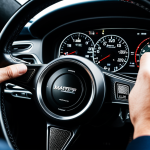Quick Preparation Checklist for Vehicle Electronics
Before transporting your vehicle, protecting electronics begins with a thorough inventory of all devices inside. This includes factory-installed gadgets and removable units like GPS trackers or aftermarket dashcams. Knowing exactly which electronics are present helps tailor the vehicle transport checklist to your needs.
Next, gather packing materials suited for electronics protection—anti-static bubble wrap, sturdy boxes, and secure straps prevent damage. Tools such as screwdrivers or plastic pry tools are essential for careful removal or fastening of delicate parts.
Also read : The Definitive Guide: Essential Tips for Optimal Turbocharger System Maintenance in Your Vehicle
Develop a plan for handling sensitive equipment. Some devices can be removed and transported separately to further minimize risk, while built-in units may require secure fastening to withstand transit jolts. This strategy ensures maximum safety while factoring in the complexity and value of your moving vehicle devices.
By proactively assessing and preparing, you streamline the transport process and reduce the chance of costly damage or loss during vehicle shipment. This checklist is an essential foundation for anyone prioritizing the integrity of vehicle electronics during transport.
Have you seen this : Complete Handbook for Securely Installing Your Roof-Mounted Bike Rack: Essential Tips for a Safe Setup
Packing, Securing, or Removing Electronics Before Transport
Safely handling your vehicle’s electronics requires specific attention to how you pack, secure devices in car transport, or remove them entirely. When it comes to how to pack electronics, start by detaching removable units such as GPS trackers, dashcams, or aftermarket alarms carefully to prevent damage or loose wiring. Use anti-static bubble wrap or padded cases to shield delicate parts from shocks during transit.
Labeling packed electronics clearly is crucial. This practice helps identify components quickly and prevents confusion upon unpacking or reinstallation. For built-in features like car stereos or factory-installed sensors, the best approach is to secure devices in car transport firmly. This means using foam padding, straps, or custom-fit enclosures to minimize movement and absorb vibrations.
Removing car electronics is recommended when devices are valuable or sensitive. However, if removal isn’t feasible, make sure to power down and protect these moving vehicle devices with stabilization methods to reduce risks from jolts or impacts. Properly packing, removing, or securing all electronics ensures maximum protection throughout your vehicle’s journey.
Risks to Electronics During Vehicle Transportation
When dealing with electronics transport risks, understanding environmental factors is crucial. Temperature fluctuations pose a significant threat; extreme heat can cause components to warp or malfunction, while cold may lead to condensation inside devices. Humidity compounds these risks by promoting corrosion and short-circuits. Protecting electronics means accounting for these variables in your vehicle transport checklist.
Vibration and shock during transit are another major concern. Continuous jolting can loosen connections or damage delicate circuits in moving vehicle devices. Securing devices firmly with padding or braces reduces this risk substantially. Consider shock-absorbing materials specifically designed for sensitive electronics to maintain integrity throughout the journey.
Theft prevention is equally important. Portable or easily removable electronics attract thieves, making secure storage or removal a priority. Use lockable compartments or transport valuable devices separately when possible. Incorporating theft deterrents adds another layer of safety, complementing the physical protection strategies needed to minimize electronics transport risks.
Recommendations for Specific Vehicle Electronics
Proper handling of car GPS transport starts with removal or secure packing. Removable GPS units should be detached carefully, wrapped in anti-static materials, and stored in padded cases. If built-in, secure them firmly to avoid movement during transit, as shifts can cause connection failures.
When protecting car stereos, power down the system completely and insulate with foam or bubble wrap to prevent vibrations from damaging internal components. Factory-installed stereos usually require additional securing using straps or custom mounts to stay stable through bumps or shocks.
For dashcam safety, removal is often advisable because these devices are sensitive and easily dislodged. If removal isn’t possible, ensure that dashcams and their wiring are fastened securely and shielded from impacts or moisture exposure. Checking the power status and disconnecting batteries can further protect these moving vehicle devices.
Each device’s unique features demand tailored care. Prioritizing these methods reduces risk of damage, helping maintain functionality and safeguarding your investment. This approach also complements steps from your vehicle transport checklist focused on electronics protection.
Insurance and Documentation Considerations
When planning vehicle transport coverage, understanding your electronics insurance transport options is essential. Standard vehicle transport insurance may not fully cover damage or loss to moving vehicle devices, so confirming the extent of coverage beforehand is critical. Specialized policies or rider clauses can provide additional protection tailored for sensitive or high-value electronics.
Documenting your electronics thoroughly supports insurance claims if incidents occur. This means creating a detailed inventory including serial numbers, make and model, plus capturing clear photos showing current condition. Such documentation is vital for both pre-transport verification and post-transport disputes related to damage or loss.
In case of loss or damage, promptly notify your transport provider and insurance company. Keep all related paperwork accessible, including the vehicle transport checklist and photographic evidence. Timely filing of claims and clear communication help expedite resolutions and improve the likelihood of compensation.
Proper electronics insurance transport and diligent documentation not only safeguard your assets but also offer peace of mind, letting you focus on other aspects of your move without unnecessary stress.
Quick Preparation Checklist for Vehicle Electronics
Start by conducting a detailed inventory of all moving vehicle devices inside your car. This includes factory-installed electronics, plus removable gadgets like GPS units and aftermarket dashcams. Exact knowledge of each device allows customizing your vehicle transport checklist to address their specific needs and vulnerabilities.
Next, gather appropriate packing materials. To protect sensitive equipment, acquire anti-static bubble wrap, sturdy boxes, and secure straps. Have handy tools for removal or securing, such as screwdrivers or plastic pry tools, ready to handle delicate tasks carefully.
Plan the removal or securement of electronics based on their type and sensitivity. Valuable or fragile devices should be removed and transported separately when possible. For built-in units, ensure they are firmly fastened using foam padding or custom braces to mitigate movement during transit.
Taking these preparatory steps ensures a robust defense when protecting electronics through every stage of your vehicle’s transport. This comprehensive approach minimizes damage risk and keeps your devices functional and intact after the journey.








